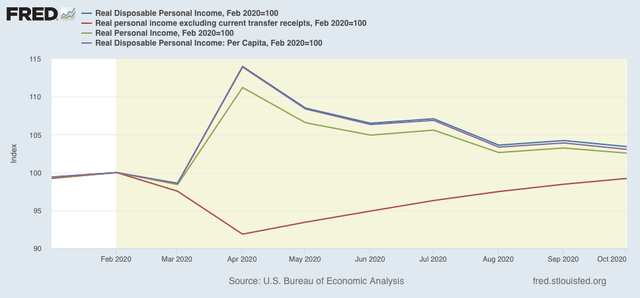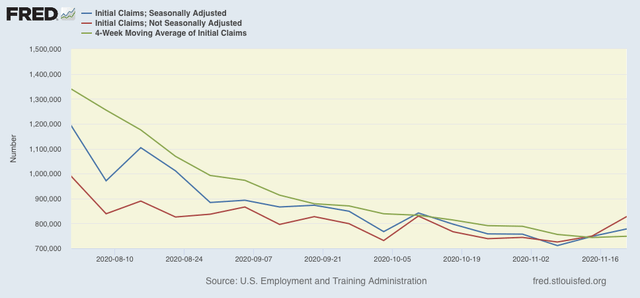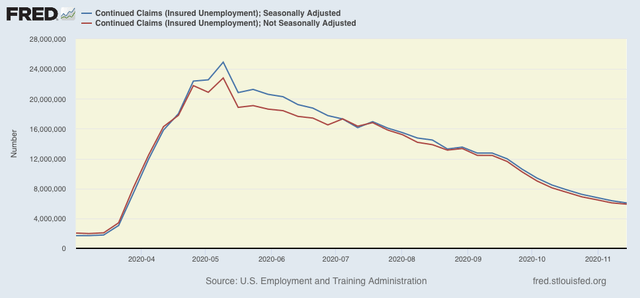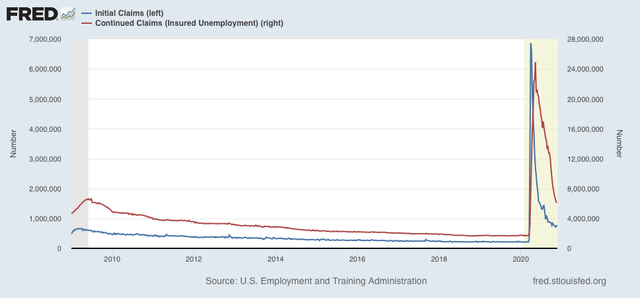Before I turn to this week’s report on jobless claims, a brief word first about October’s personal income and spending.
Although personal income declined in October compared with September, more importantly depending on how you measure it, real personal income is still 2.6% to 3.4% *higher* than it was at its peak in February just before the onset of the pandemic:

Much of that is the emergency pandemic aid passed by Congress. When you take out such “government transfer receipts,” personal income actually continued to improve in October, but is still -0.8% below its February peak.
This demonstrates the efficacy of the emergency aid, the urgency of continuing it after the end of the year as the pandemic continues to rage, and also is a likely explanation for why Trump did considerably better, even though he lost, than other economic fundamentals forecast.
Bottom line: we need renewed Congressional aid until the promising vaccines are widely available.
Turning now to this week’s new jobless claims, they increased further from the pandemic lows of two weeks ago, while continued jobless claims, which lag slightly, again declined to new pandemic lows.
On an unadjusted basis, new jobless claims rose by 48,360 to 827,710. Seasonally adjusted claims rose by 30,000 to 778,000, which is also 67,000 higher than their pandemic lows two weeks ago. The 4 week moving average also rose from last week’s pandemic low by 5,000 to 748,500. Here is the close up since the end of July (for comparison, remember that these numbers were in the range of 5 to 7 million at their worst in early April):

Unadjusted continuing claims, which -importantly – lag initial claims typically by a few weeks to several months, continued to decline by 167,617 to 5,911,965. With seasonal adjustment they declined by 299,000 to 6,071,000, both new pandemic lows:

Seasonally adjusted new jobless claims have declined about 88% from their March and April pandemic high, and continuing claims have declined about 75% from the April high:

Both of these are slightly higher than their worst levels of the Great Recession.
It appears increasingly likely that two weeks ago will mark an interim low, due to the pandemic spiraling out of control again in most of the country. How much worse the jobless situation gets will depend on how much worse the pandemic continues to get. In particular, even without lockdowns increasingly cautious or frightened people are going to engage in less economic activity that involves in-person social interactions.





any governmental action to now stimulate the economy could end up as spreading the virus more. what we need to now do is to encourage governmental gals and guys to pay down public debt so that when the virus is gone will have less debt, plenty money with which to stimulate. here again cash should be used wisely. we get more bang for the buck twhen the stimulation in effect takes money from the extremely wealthy and transfers it to the extremely poor most of whom live in other countries. how do you give money to poor people in other countries so that it doesn’t simply drop into the pockets underworld Psychopaths? you give those people something that cannot be easily stolen, something worthless when it is stolen. you give them streets, roads, and highways. the mob will not cut off a piece of concrete to put into their pockets, what good is it to them. do you see the difference? these are the things we need. during the Great Depression Huey Long built roads — bless his
Immortal
soul
!
but, but, they are not working and are on Medicaid, chips, snaps, household subsidies, etc. but, but, those 18 year olds should have known better than to sign up for student loans, but, but, it will cost $billions of taxpayer money . . . and it goes on and on the excuses to do nothing.
Reinventing Workers for the Post-Covid Economy
NY Times – Eduardo Porter – December 1
Especially in service industries, old jobs may not be coming back. Training programs are aiming to provide skills for more resilient occupations.
… The nation’s economic recovery from the Covid-19 pandemic will hinge to some extent on how quickly show managers can become electricians, whether taxi drivers can become plumbers, and how many cooks can manage software for a bank.
The labor market has recovered 12 million of the 22 million jobs lost from February to April. But many positions may not return any time soon, even when a vaccine is deployed.
This is likely to prove especially problematic for millions of low-paid workers in service industries like retailing, hospitality, building maintenance and transportation, which may be permanently impaired or fundamentally transformed. What will janitors do if fewer people work in offices? What will waiters do if the urban restaurant ecosystem never recovers its density?
Their prognosis is bleak. Marcela Escobari, an economist at the Brookings Institution, warns that even if the economy adds jobs as the coronavirus risk fades, “the rebound won’t help the people that have been hurt the most.”
Looking back over 16 years of data, Ms. Escobari finds that workers in the occupations most heavily hit since the spring will have a difficult time reinventing themselves. Taxi drivers, dancers and front-desk clerks have poor track records moving to jobs as, say, registered nurses, pipe layers or instrumentation technicians.
“Many of today’s unemployed workers may find it harder than in the past to find new jobs and advance through the labor market,” Ms. Escobari wrote.
(graph at the link)
Covid is abruptly taking out a swath of jobs that were thought to be comparatively resilient, in services that require personal contact with customers. And the jolt has landed squarely on workers with little or no education beyond high school, toiling in the low-wage service economy.
“The damage to the economy and particularly to workers will probably be longer lasting than we think it is going to be,” said Peter Beard, senior vice president for regional work force development at the Greater Houston Partnership, an economic development group.
What’s more, he said, Covid will intensify underlying dynamics that were already transforming the workplace. Automation, for one, will most likely accelerate as employers seek to protect their businesses from future pandemics. …